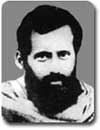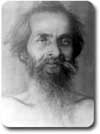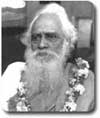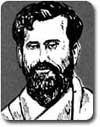

Loading Section...
| Page 1 | Page 2 |
It is significant that in the beginning of the 20th century when many organisations and a host of important individuals engaged themselves in the task of redressing the political and socio-economic ills of Odisha, a small open air minor school which later became a High School, and then converted to National School with the name of Satyabadi Vihar, was to play a vital role in shaping the history of the region.
The Satyabadi School established on 12 th Agust 1909 may be said to be the cradle of the National Movement in Puri District . It was at Sakhigopal or Satyabadi, 11 miles north of Puri and in the midst of mango and bakul groves.The school was the product of lofty idealism of few young intellectuals who were convinced that much of the evil could be eradicated through proper development and training. Along with their studies, they taught the essence of life which would make them complete human being; courageous, confident and ready to work for the uplift and progress their brethren.
A band of selfless youngmen namely Pandit Gopabandhu Das, Acharya Harihar Das, Nilakantha Das, Krupasindhu Mishra, Godavarish Mishra who distinguished themselves in later life as scholars and national leaders popularly known as 'Pancha-Sakha'. sincere efforts. The Pancha-Sakha or five comrades contributed their best for the cause of national aspirations. They were equally dedicated to the blend of educational as well as political uplift of Odisha.
Gandhiji's visit to this place in 1921 gave further impetus to the spirit of the students at Satyabadi. They now grew up their studies and became active members of the Congress. Hence forth, Satyabadi became an active centre of non Co-operation movement rather than a model educational institution. The Satyabadi School was in the true spirit of a national school as its main objective was to become a honey-comb of India struggle of freedom.

Utkalmani Gopabandhu Das
Gopabandhu Das was born in Swando village of Puri district in Odisha in the year 1877 9th October. He is one of the founders of modern Odisha, also remembered for his patriotic lyrical poems and lucid, thought provoking writings. Gopabandhu Das was a public spirited Gandhian of Utkal who championed the cause of the statehood of Odisha. After graduation, he got his Law degree and joined the Bar. But he diverted his legal profession and became a devotee of the people of Odisha.
He championed the cause of the formation of the Odisha state for the Odia-speaking people, started the Satyabadi (a literary monthly). He edited Asha, a newspaper from Berhampur and later launched his own weekly Samaj from Puri in 1919 (which later became the most widely circulated daily newspaper of Odisha). He had launched the 'Kartavya Padhini Samiti' (duty awakening society) for securing the Odias, their rights and privileges. Gopabandhu Das was a great orator and his speeches made at the Bihar-Odisha legislature of which he was a member, showed his excellent style of oratory as well as clarity of thought and concern for the poor. One may point at him as the father of modern Odia journalism. His essays on education easily prove that he was an educationist of great insight and understanding. His ambition from childhood was to be a poet. Absorbed in social activities he had little time for literary endeavours, yet while imprisoned in the Hazaribagh Jail (1922-1924) for participating in the Indian Freedom Movement, he wrote 'Bandira Atmakatha' (The soliloquy of a Prisoner) and 'Dharmapada'. Bandira Atmakatha is the expression of his deep love for the people of Odisha and Dharmapada is the story of the twelve-year-old artisan boy who, after completing the Konark temple, drowned himself in the sea to save the lives and prestige of the twelve hundred artisans of Odisha. Though not a poetic genius, his sincerity of feelings and simple diction touches the heart of the reader. Educated Odias are often found quoting a line or two from his verses such as 'Mishu Mora Deha E Desha Matire' (Let this body of mine merge with the soil of this country), 'Pachha Ghuncha Nahin Birara Jatake' (The valiant never retreats), or 'Raha Raha Kshyane Vaspiya Sakata, Dekhibi Chilika Charu Chitrapata' (A poem dedicated to the beauty of Chilika Lake ). A prolific writer in English and Odia, Gopabandhu had a unique style of presentation of his ideas. He is often referred to as the Father of Modern Odisha. He was conferred the honorary title of Utkalamani (The jewel of Utkal/Odisha) by the people of Odisha.

Acharya Harihar
Acharya Harihar led the famous Inchudi salt Satyagraha in Odisha. This Satyagraha elevated Odisha's image in the eyes of the nation.

Pandit Nilakantha Das
PANDIT NILAKANTHA DAS (1884-1967) was a politician, versatile scholar, critic and poet. His major contribution to Odia poetry are his works 'Konarke' and 'Mayadevi' , in which he has tried to deviate from the prevailing poetic norm established by the famous poet Radhanath Roy. His 'Dasa Naik' and 'Pranayini' are successful Odia adaptations of Lord Tennyson's 'Enoch Arden' Pandit Nilakantha is also a poerful writer of Odia prose. His 'Odia Sahityar Kramaparinam' is a landmark in Odia literary criticism. He received the Central Sahitya Akademi Award for his autobiography. 'Atma Jivani'. He was also a great Parliamentarian during the pre and post Independence era of the country.

Pandit Godabarish Mishra
Pundit Godabarish Mishra had taken birth in Srinibaspur sasan a place nearby Banapur of Puri district. His parents had decided after taking holy dip in the river Godavari during their 'Godavari Tirtha' that they would keep the name of their son Godabari.
After completing his primary education from his village school he passed his entrance from Puri District School in 1906 and joined in Revenshaw College. He used to take tuition to meet the college fees so that he can read in the college, as he was poor. He passed his BA in 1910 in Philosophy. He went to Calcutta to read MA and passed his MA in 1912 in Economics (arthaniti). He took part in the non-cooperation movement in 1921. In 1922 he returned to his village and was involved in establishing schools, small-scale industries (kutir shilpa), farm & cultivation and social welfare organisations. He was the Editor of 'Samaj' for around two years in 1928 after the death of Gopabandhu. His political life began from 1924. He was inspired by Mahatma Gandhi & Gopabandhu and joined the congress. After Odisha got its independence he was the member of Odisha Vidhan Sabha from 1937 till his death excepting for five years break in the middle. He became Vidhan Sabha member in 1952 as an independent candidate. He served in the Vidhan Sabha as an eminent administrator and member of the opposition party. He left 'Congress' in 1939 and joined the 'Forward Block'.
He was associated with Utkal Samilani from 1919 to 1955. He was the President of Utkal Samilani special conference that was held at Berhampur in 1955. He was one of the 'Pancah-sakha' (five friends) of Gopabandhu. He came across Pundit Gopabandhu while he was in hostel and was involved in welfare of the country. He was a high standard politician, pundit, educator, historian, poet, writer, editor and orator. His works include many essays, stories, drama, novels, poems, biographies, travel stories, general knowledge, translation, workbooks, jokes etc. His poem 'Kalijai', 'Kishalaya' electrifies the life of Odia. His poems have played an important role in creating awareness towards the nation and is heart touching. He published a magazine 'Lokamukha' from Banapur in 1924. He was also the editor of 'Samaj'. He was awarded Doctorate from the Utkal University.

Pandit Krupasindhu Mishra
PANDIT KRUPASINDHU MISHRA (1887-1962) devoted himself chiefly to historical writing. His outstanding contributions in this field are his 'Odisha Itihas', 'Konarka' and 'Barabati'.
The Satyabadi school had an indigenous character while striving for the fusion of the old with the new. It strove to restore the old Ashram school without emphasis on a sound mind in a sound body and plain living and high thinking. It was a factory to build up the personality of man. The most outstanding contribution of the Satyabadi school was the sense of nationalism and patriotism that it infused in the youth preparing them for the freedom struggle.
| Page 1 | Page 2 |
Loading Section...
Loading Section...